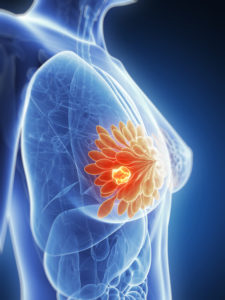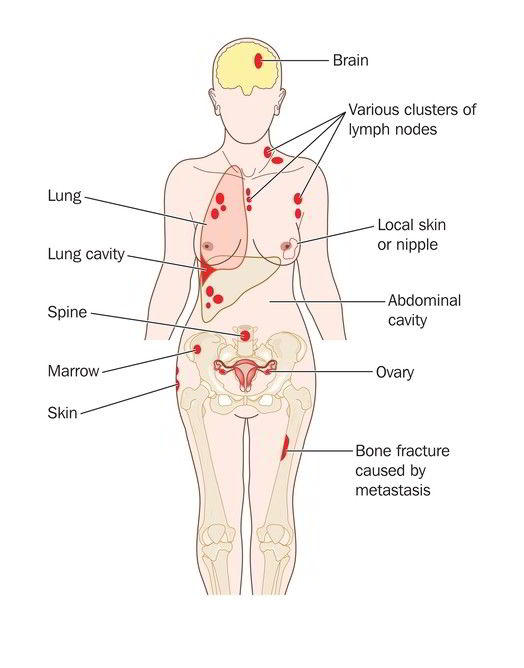Home » Breast Cancer » Page 2
Breast Cancer
 About Breast Cancer
About Breast Cancer
One out of seven women will develop breast cancer sometime throughout her life. Approx. 1% of all breast cancer cases appear in men.
Breast cancer is diagnosed following taking a biopsy or removal of cells from the afflicted tissue during surgery and diagnostic analysis.
Early detection affects the disease treatment plan and also treatment success.
The existing therapies used for stage 4 metastatic breast cancer are not curative, and this is a source of the need for innovative and effective treatment strategies in order to fight the disease.
The National Cancer Institute, NCI, highlights the fact that for a certain group of breast cancer patients, the best treatment option is to join one of the many clinical trials existing worldwide aiming to increase their chances of therapeutic success.
Classification
The disease is classified according to the breast cells from which it develops. In most cases the source is the epithelial cells in the breast tissue, thus the disease is called “Adenoarcinoma”.
In some cases, the disease develops in the milk ducts which transfer milk from the glands to the nipples (milk ducts or the milk ducts that produce milk, lobules).
The disease can be local, locally spread or metastatic, which is also called “Stage 4”.
Types of Breast Cancer
Breast cancer is classified according to the type of receptors found on the cell. A “receptor” is a molecule located on the external shell of the cancerous cell to which ligands bind. A “ligand” is a molecule smaller than the receptor that triggers intracellular biological processes including proliferation and survival processes of the cancerous cells.
HER2 Positive
HER2 is a protein that naturally occurs on shells of normal cells of our bodies. In approx. 20% of breast cancer cases, this protein appears in excess. At the present, a number of biological drugs exist that bind to this protein and prevent its proliferation.
- ER+/PR+/HER2+
- ER-/PR+/HER2+
- ER+/PR-/HER2+
- ER-/PR-/HER2+
The cancer tumor contains receptors to Estrogen and Progesterone. It is considered to be the cancer type that has particularly high therapeutic success.
- ER+/PR+/HER2+
- ER+/PR+/HER2-
- ER-/PR+/HER2+
- ER-/PR+/HER2-
- ER+/PR-/HER2+
- ER+/PR-/HER2-
Triple Negative Breast Cancer
The cancerous tumor does not contain the three receptors HER2, Estrogen and Progesterone. It is considered a particularly aggressive, with a very low curability index and is treated, for the most part with chemotherapy which has a response rate of only 1-2%. This cancer constitutes approx. 15% of all breast cancer cases.
- ER-/PR-/HER2-
Triple Positive Breast Cancer
the tumor includes receptors for HER2, Estrogen and Progesterone. Considered to be a curable cancer.
- ER+/PR+/HER2+
There are more types of less common breast cancers such as
- Inflammatory breast cancer
- Metaplastic breast cancer
- Breast cancer among men
Stage 4 Metastatic Breast Cancer
Stage 4 metastatic breast cancer is a cancer that started in the breast and its cells have spread to other body organs, distant from the breast, and created new lesions. These lesions are called “metastases” and are made of breast cancer cells.
Breast cancer metastases may appear in the bones, liver, lungs and brain. The formation of metastases constitutes a threat on life.
Even though the cancer has spread to other organs, it is still defined as a breast cancer and is treated as breast cancer. In this manner for example, a lesion in the lung that is a metastasis of breast cancer shall be treated with breast cancer drugs and not lung cancer drugs.

Risk Factors
- Age
- Obesity
- First menstrual period at a young age and before the age of 12
- Dense breast tissue in mammography
- Family history and first tier relations with a breast cancer patient, or a disease in the past
- Presence of the mutations BRCA1 and BRCA2
- Presence of the genes PALB2, CHEK2 and PTEN
Symptoms
- A lump in the breast that is palpable
- A swelling of the breast or the armpit area
- A change in the breast appearance or a drop of the breast
- Reddish, inflamed and rough looking (“orange peel” texture) or irritated breast skin
- The nipple is enlarged, bleeding, swollen, inflamed or retreating in
To read more about Breast Cancer Symptoms>>
Treatment Goals
The goal of treating local breast cancer, not metastatic, is to remove and eradicate the tumor completely.
In metastatic stage 4 disease, the primary objective of the treatment is to slow down and control disease progression and help reduce symptoms as well prolong life and improve patient’s quality of life.
Standard Treatments
A number of therapies are possible, and many patients shall receive more than one type of therapy.
Surgery
The surgery’s goal is to remove the tumor in its entirety without harming the breast or its function.
At present, multiple innovative surgeries are offered to patients, which allow reduction of the health and cosmetic damages caused to the breast.
It is considered a success when a tumor is removed in full, however, not all surgeries are necessarily so. At times the tumor is branched and can only be partially removed.
In patients with genetic disposition there are cases where both breasts are removed in order to prevent a recurrence of the disease, for example patients who are BRCA gene carriers.
Two main types of treatment may be offered to patients before and after surgery
- Treatment prior to surgery is known as ‘Neoadjuvant’
Usually this stage of treatment will involve chemotherapy and/or radiotherapy intended to reduce the tumor’s size and improve the success of surgery.
- Post-surgery treatment, also known as ‘Adjuvant’
This treatment seeks to cure and prevent the appearance of metastases or recurrence of the tumor.
Breast cancer, when metastasized is categorized as stage 4, is considered inoperable.
Radiotherapy
This involves use of radiation at higher levels of energy aims to kill the cancer cells remaining in the post-operative area.
Radiation may also cause decelerated growth of the localized tumor remaining in the area, or local recurrence.
In many cases, Neoadjuvant radiation will be used to shrink and reduce the tumor.
Chemotherapy
Chemotherapy is a medicated therapy which aims to shrink and erase cancerous cells and allow control over the disease.
Chemotherapy carries serious side effects, while its effectiveness is insufficient.
Chemotherapy’s impact has a range of side effects such as hair loss, loss of appetite, changes to bowel movements, fatigue, infection, hemorrhaging, incontinence, pain, and more.
Common chemotherapy treatments for breast cancer include
- Texanes, e.g. Taxol, Taxotere, Docetaxel
- Abraxane® (Paclitaxel)
- Anthracyclines, e.g. Doxorubicin, Doxil, Epirubicin
- Palatinum salts, e.g. Carboplatin and Cisplatin
- Navelbine® (Vinorelbine)
- Xeloda® (Capecitabine)
- Gemzar® (Gemcitabine)
Hormonal Therapy
Drugs which role is to block the estrogen receptor
Anti – hormonal, anti – estrogen medications.
Anti estrogen drugs
Biological Therapies
Anti – Angiogenesis
Cancer tumors survive and thrive in the body by causing the body to produce a system of blood vessels around them that nourishes them and provides them with oxygen.
Anti – angiogenesis agent is a biological antibody which harms the cancerous tumor capability to induce blood vessels growth around it from the environment where it is located, to nourish it so it continues to grow and proliferate. In this way the tumor is “starved” to death.
Examples of angiogenesis inhibitors
HER2 Biological Antibody Treatment
CDK4/6 Inhibitor
mTOR Inhibitors
Targeted Therapies (by mutation or a protein)
A mutation is a change in the cell’s DNA sequence, the genetic code of the cell.
Mutations may occur when mistakes happen during the cell’s division process, or they may be caused by exposure to DNA harming agents such as free radicals, asbestos and others. At times healthy cells mutations may cause the generation of cancer in the body.
BRCA 1,2 mutation
An example of a common mutation in breast cancer and a drug that acts to fight it:
Clinical Trials for Breast Cancer
Facts
- The existing therapies used on stage 4 metastatic breast cancer are not curative, and this is a source to the need for innovative and effective treatment strategies in order to fight the disease.
- The National Cancer Institute, NCI, highlights the fact that for a certain group of breast cancer patients, the best treatment option is to join one of the many clinical trials existing worldwide aiming to increase their chances of therapeutic success.
- Currently, every patient will be offered the standard protocols described above. Sometimes the oncologist may suggest integrating these therapies with trials carried out in the institute.
The Opportunity
- Advances in cancer therapies may be found in clinical trials prescribing cutting edge, innovative drugs, some of which have already been recognized by the US Food & Drug Administration, the FDA, as “breakthrough drugs” and require further information to be approved.
- An entire world of clinical trials, Compassionate drugs and advanced new cancer treatments are available worldwide.
- It is important to know and have access to cutting edge cancer treatments that best match the unique medical condition of the patient and increase chances in winning the fight against compared to the standard care offered.
Note to remember!
Not every patient is eligible to enter a specific clinical trial. The eligibility conditions must be fully met and each case is reviewed separately to ensure that the clinical trial matches to the specific cancer patient and vice versa.
References
https://www.fda.gov/
https://www.ema.europa.eu/
https://www.health.gov.il
http://mbcn.org/
breastcancer.org
https://www.cancer.gov
https://www.cancer.org/
https://www.cancerresearchuk.org/
Dear Reader
This information is provided as a source of knowledge and does not constitute a medical consultation. For professional medical advice, see your attending physician. Information regarding drugs and commercial names belongs to the pharmaceutical companies
To check if our service suits your case
We need to talk

Improve therapeutic outcomes, prolong life and quality of life, are our main business.
We support access to and expand cancer treatments beyond the standard of care, with the most advanced and innovative treatment options in the world, personally matching the individual cancer patient’s medical condition and with the support of top tier oncologists.
Article categories
קטגוריות המאמרים
Popular topics











